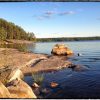Kazan, Ferguson & Wilson Rivers Summary
TRIP LOG: Submitted by Mel Baughman, May 2015
Nunavut, Canada
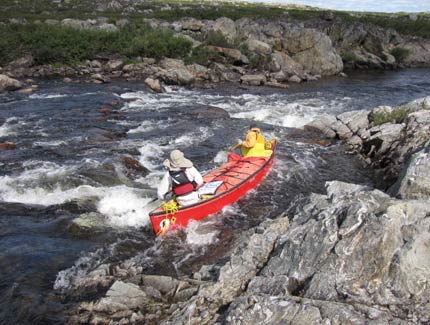
Route:
This expedition began on Lynx Lake at the headwaters of the Thelon River and ended at the Hamlet of Whale Cove on Hudson Bay. It covered about 605 miles over the course of 47 days, beginning on July 2 and ending on August 16, 2012. There was a partial crew change in the middle of the trip. The first crew paddled the Thelon, Dubawnt, and Nowleye rivers while the second crew began at Nowleye Lake and covered parts of the Kazan, Ferguson, and Wilson Rivers. The report below covers the second half of the trip from Nowleye Lake to Hudson Bay.
Jim Gallagher, Brian Johnston, Iva Kinclova, and Lee Sessions had been on the trip for several weeks when Brian Arquilla and I flew up to meet them and replace two crew members (Rob Jordan and Lisa Goodman). Brian and I flew from Winnipeg to Kasba Lake Lodge on their chartered plane, spent three nights at the lodge, and then flew up to Nowleye Lake in a Beaver with our gear and all food for the remainder of the trip.
Over the next 25 days our crew covered 393 miles. We passed through Nowleye, Angikuni, and Yathkyed Lakes on the Kazan River system; then down the Ferguson River, including Ferguson, Kaminuriak, Mackenzie, O’Neill, and Quartzite Lakes; then finally down the Wilson River, including Maze and Whiterock Lakes. While the Ferguson River flows into Hudson Bay, we portaged over to the Wilson River because its mouth is closer to Whale Cover, thus shortening our paddle on the Bay. A 20-mile paddle along the shore of Hudson Bay took us to the Hamlet of Whale Cove. From there we flew back to Winnipeg on a commercial plane and I drove home to Wisconsin.
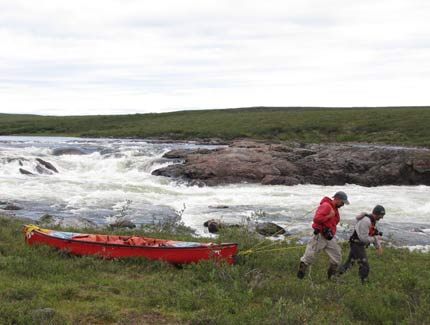
River Conditions:
The first crew was about three days behind schedule when Brian and I flew up for the crew change. Difficult upstream travel and several windbound days on big lakes led to the delay. As a consequence the second crew paddled many long days in the first half of our journey to catch up and build in some extra time in case we were windbound again. Along the Kazan River system we paddled through several huge lakes, portaged around three closely spaced ledges, and ran some big whitewater. To minimize wind problems on big lakes we usually were on the water by 7:30 am and once paddled in darkness until 2:00 am. Swift current allowed us to cover 32 miles one day.
Overland travel between the Kazan and Ferguson River watersheds required about 3 ½ miles of portaging interspersed with a couple of short paddles on small lakes. This trek took two exhausting days.
The Ferguson River watershed led us through a couple of small lakes separated by shallow rock gardens that required a little dragging. The river was quite small in the beginning, but gradually grew to be 200 yards wide with huge rapids requiring lining and portaging. On the Ferguson River we had two portages, each about ¼ mile long, and many challenging, but fun rapids to run.
We paddled just three short days on the Wilson River through two lakes and past six rapids. We had a short portage and a mile-long portage; ran through four rapids and lined past two short rapids. The Wilson averaged about 20 to 30 yards wide. We found a few cabins along the Wilson River. Its lower reaches were accessible by all-terrain vehicles from Whale Cove. A gravel road extended from Whale Cove to the mouth of the Wilson.
We had good travel conditions on the Bay and covered 20 miles to Whale Cove in one day of paddling. We had calm wind in early morning, then strong wind in late morning, followed by calmer wind again in the afternoon. While paddling among islands for wind protection, we were stranded for a short time by low tide, but in 30 minutes the rising tide raised us over a gravel bar. We had to portage over another gravel bar that would not have been covered by water for several more hours.
Whale Cove with a population of 407 was a very friendly hamlet. It receives few visitors so many people came to the beach to greet us when we arrived. Iva knew the school principal so we were invited to stay overnight in the school where we gave PowerPoint presentations about our trip to the students. Our three canoes and some paddles were sold to local residents.
Landscape:
Land along the Kazan River, especially around the big lakes, was generally flat, but there were a few hills in scattered places. Most of the Ferguson River was bordered by hills with exposed bedrock. It was the most scenic river I have canoed on the tundra and it provided interesting hiking. Land along the Wilson River had some low hills in the headwaters, but they receded away from the river as we approached the Bay. Land along the Bay was quite flat with extensive bedrock exposed.
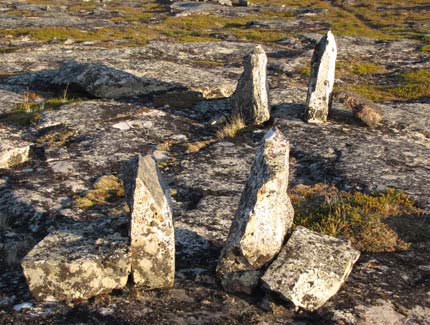
Vegetation:
The entire trip was through the tundra. Knee-high shrub cover was common along the Kazan watershed, but it gradually diminished and mostly disappeared when we reached the Ferguson River watershed. Common species included: dwarf birch, willow, Labrador tea, blueberry, crowberry, cloudberry, cranberry, bearberry, mosses, lichens, wild flowers. Toward the end of our trip all the berry-producing shrubs had abundant, ripe berries.
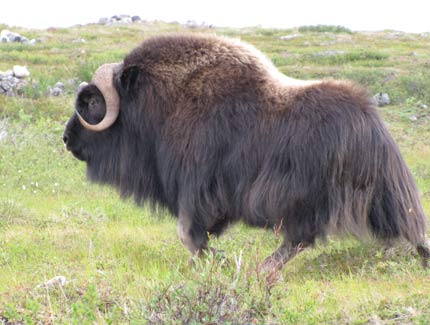
Insects, Fish, and Wildlife:
Black flies were a major nuisance along the entire river route. Mosquitos were a nuisance mainly in the evenings and calm mornings.
We caught lake trout throughout the trip and arctic grayling in a few places along the Ferguson River. The Ferguson appeared to be an excellent grayling river, especially in its headwaters, but we had little time to fish. I would be interested in repeating the Ferguson and Wilson River portion of the trip, just for the great fishing we encountered when we had time to fish.
We saw muskoxen along the Kazan River watershed, but none on the Ferguson or Wilson rivers. Nearly every day of the trip we saw caribou and twice encountered massive herds. The first herd was on the western edge of Angikuni Lake and the second was along the Kazan River between the Cascades and Yathkyed Lake. We also saw wolf, fox, wolverine, arctic ground squirrel, rock ptarmigan, willow grouse, greater white-fronted goose, snow goose, Canada goose, tundra swan, gadwall, American widgeon, mallard, blue-winged teal, northern pintail, greater scaup, lesser scaup, common eider, surf scoter, white-winged scoter, black scoter, oldsquaw, red-throated loon, pacific loon, common loon, red-necked grebe, double-crested cormorant, peregrine falcon, bald eagle, northern harrier, golden eagle, whooping crane, American golden plover, grey plover, semipalmated plover, killdeer, piping plover, whimbrel, greater yellowlegs, spotted sandpiper, semipalmated sandpiper, least sandpiper, dunlin, ring-billed gull, glaucous-winged gull, herring gull, bonaparte’s gull, common tern, arctic tern, long-tailed jaeger, short-eared owl, common raven, horned lark, common redpoll, hoary redpoll, yellow warbler, Lapland larkspur, fox sparrow, Harris’s sparrow, white-crowned sparrow, white-throated sparrow, dark-eyed junco, and American tree sparrow. (Thanks to Brian Arquilla for the bird list!)
For protection from polar bears, beginning 54 miles from the coast we pitched our tents close together and installed a 3-strand electric fence around the camp each night. Two motion detectors also were set up. We also carried two shotguns loaded with slugs. Nonlethal ammunition included rubber bullets and bean bag shells as well as bear bangers and pepper spray to be used if circumstances required.
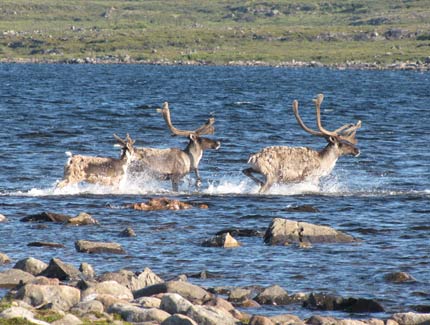
Campsites:
We had little difficulty finding campsites. All sites were on the tundra. Many sites showed previous Inuit use.
Cabins and Artifacts:
There was an abandoned cabin at the outlet of Ferguson Lake, a small outpost fishing camp at the outlet of Kaminuriak Lake, a fishing lodge and cabins on Quartzite Lake, and cabins along the Wilson River from Whiterock Lake downstream.
Throughout the trip we frequently saw standing rocks and rock-on-rock markers, Inuksuit, and tent rings. Meat caches, hunting blinds, and kayak stands were relatively common. We also found a few graves. There was a treasure trove of these rock structures along the Ferguson River where rocks were abundant.
Canoes & Equipment:
Our crew of six paddled three Old Town Discovery 174s with spray covers and lining ropes. Besides our three 2-person tents, a bug tent and 12’ x 16’ Tundra Tarp from Cooke Custom Sewing were very useful shelters.
My Costs: ~$4,800
Maps: mostly 1:50,000 customized from mytopo.com
Kasba Lake Lodge: Assistant Manager and Sales, Matt Hill, Canadian Office: 800-663-8641, Cell: 250-951-4791; matt@kasba.com
Calm Air: Calmair.com
By Mel Baughman, Hayward, Wisconsin
For a complete journal with more details, contact the author—baughman@umn.edu.
Crew: Brian Arquilla, Mel Baughman, Jim Gallagher, Brian Johnston, Iva Kinclova, Lee Sessions


